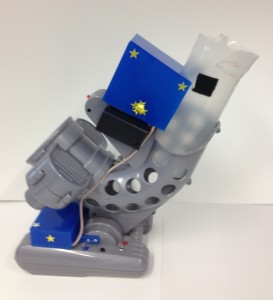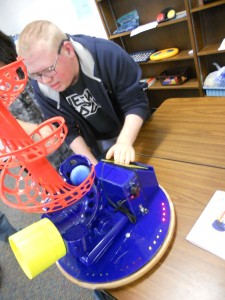Designers: Devin Rojas, Eric Wang, Sophia Ziemien
Client Coordinators: Trudy Maness, teacher, and Victoria Guthrie, PT
Supervising Professors: Kevin Caves and Richard Goldberg
INTRODUCTION
Our clients are students in an elementary school classroom with a variety of physical and cognitive disabilities. The students have varying levels of physical impairments; some use wheelchairs or walkers, while others can walk independently. All of the students also have some level of cognitive impairment. The teachers and therapists requested a recreational activity that would encourage peer interaction.
We developed a system that allows our clients to toss a ball between two stations. The device (Figure 1) can assist with development of fine and gross motor skills and cognitive awareness of cause and effect. Pressing a button causes a single ball to be tossed from one station to the other or to a partner. If the ball successfully enters the goal or a funnel it triggers an audio message. The system provides a fun, safe recreational activity for our clients. Although the abilities of our clients vary from student to student, all of the children are able to operate a switch and have a basic understanding of cause and effect.
STATEMENT OF IMPACT
The classroom teacher and physical therapist stated: “Gross motor skills as well as fine motor skills, are all part of their education. So this device helps with eye-hand coordination. I have seen them take turns. It [helps them with] practice, helps them to decrease impulsivity. I think it’s just going to be a wonderful tool to empower them and also help their self- esteem and also have fun.”
TECHNICAL DESCRIPTION
The ball tossing device is a modified Franklin MLB Kid Pitching Machine as shown in Figure 1. To operate the device, the student presses a commercial Big Red (or similar) switch that is plugged into the input jack on the device. When the switch is pressed, a solenoid retracts and releases a single ball into the launcher mechanism and the ball is tossed. The distance the ball travels can be adjusted via a potentiometer on the device, allowing customization for different ages, abilities and play scenarios. Two pitching devices were modified and a ball catcher has also been designed to allow two children with significant disabilities to play catch.
The Franklin MLB Kid Pitching Machine is designed to pitch one ball every 10 seconds. We bypassed the gear-based timing mechanism that released one ball every ten seconds, and installed a solenoid that when activated, releases only one ball into the launcher tube. The solenoid is activated using an Arduino Uno controller. The motors on the pitching machine are powered by 3 D-cell batteries and the custom circuit and solenoid are powered by a 9V battery.
To facilitate interaction between children, a ball catcher was designed. The ball catcher is a conical device that is held into its catching shape with Velcro. Velcro allows for easy release and flattening of the cone for efficient storage. The catcher can also be attached to the top of the ball toss device in order to allow for use with a partner as previously described. The device can placed on a wheeled stand that doubles as a plastic storage container for the entire device.
The total cost to produce 2 ball toss devices was $310.

